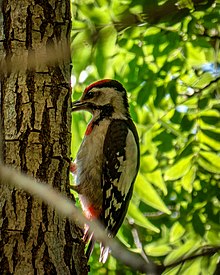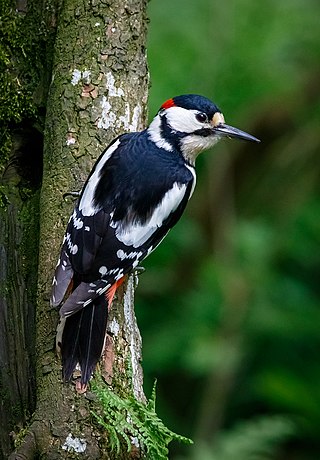
The great spotted woodpecker is a medium-sized woodpecker with pied black and white plumage and a red patch on the lower belly. Males and young birds also have red markings on the neck or head. This species is found across the Palearctic including parts of North Africa. Across most of its range it is resident, but in the north some will migrate if the conifer cone crop fails. Some individuals have a tendency to wander, leading to the recolonisation of Ireland in the first decade of the 21st century and to vagrancy to North America. Great spotted woodpeckers chisel into trees to find food or excavate nest holes, and also drum for contact and territorial advertisement; like other woodpeckers, they have anatomical adaptations to manage the physical stresses from the hammering action. This species is similar to the Syrian woodpecker.

The lesser spotted woodpecker is a member of the woodpecker family Picidae. It was formerly assigned to the genus Dendrocopos. Some taxonomic authorities continue to list the species there.

The wrynecks are a small but distinctive group of small Old World woodpeckers. Jynx is from the Ancient Greek iunx, the Eurasian wryneck.

The hairy woodpecker is a medium-sized woodpecker that is found over a large area of North America. It is approximately 250 mm (9.8 in) in length with a 380 mm (15 in) wingspan. With an estimated population in 2020 of almost nine million individuals, the hairy woodpecker is listed by the IUCN as a species of least concern. Some nomenclature authorities, such as the eBird/Clements checklist, place this species in the genus Dryobates.
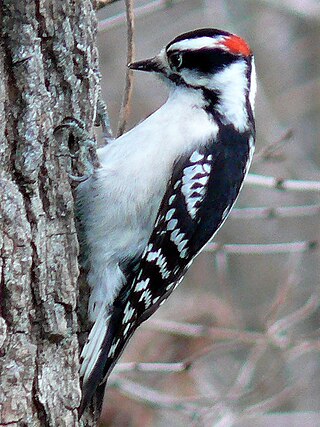
The downy woodpecker is a species of woodpecker, the smallest in North America. Length ranges from 14 to 18 cm. Downy woodpeckers primarily live in forested areas throughout the United States and Canada, with the exception of deserts in the southwest and the northern tundra. The bird nests in tree cavities and feeds primarily on insects, although it supplements its diet with seeds and berries. The downy woodpecker is very similar in appearance to the hairy woodpecker, although they are not closely related.
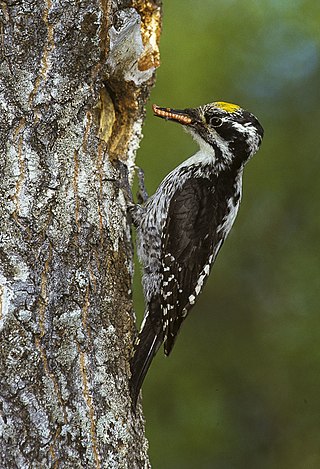
The Eurasian three-toed woodpecker is a medium-sized woodpecker that is found from northern Europe across northern Asia to Japan.

The Eurasian scops owl, also known as the European scops owl or just scops owl, is a small owl in the typical owl family Strigidae. Its breeding range extends from southern Europe eastwards to southern Siberia and the western Himalayas. It is migratory, wintering in Africa south of the Sahara.

The red-billed firefinch or Senegal firefinch is a small seed-eating bird in the family Estrildidae. This is a resident breeding bird in most of Sub-Saharan Africa with an estimated global extent of occurrence of 10,000,000 km2. It was introduced to Egypt, but the population there has become extinct. It was also introduced to southern Algeria where it is currently expanding northward.

The white-backed woodpecker is a Eurasian woodpecker belonging to the genus Dendrocopos.

Picus is a genus of birds in the woodpecker family. It has representatives in Europe, Asia and North Africa. The genus name is Latin for "woodpecker". The genus Picus was erected by the Swedish naturalist Carl Linnaeus in 1758 in the tenth edition of his Systema Naturae.

Dendrocopos is a widespread genus of woodpeckers from Asia, Europe and Northern Africa. The species range from the Philippines to the British Isles.
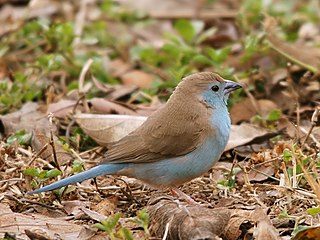
The blue waxbill, also called southern blue waxbill, blue-breasted waxbill, southern cordon-bleu, blue-cheeked cordon-bleu, blue-breasted cordon-bleu and Angola cordon-bleu, is a common species of estrildid finch found in Southern Africa. It is also relatively commonly kept as an aviary bird.
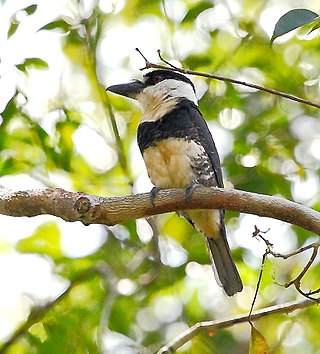
The Guianan puffbird is a species of bird in the family Bucconidae, the puffbirds, nunlets, and nunbirds. It is found in Brazil, French Guiana, Guyana, Suriname, and Venezuela. It was formerly considered to be conspecific with the white-necked puffbird and the buff-bellied puffbird with the English name "white-necked puffbird".

The guira tanager is a species of bird in the family Thraupidae.
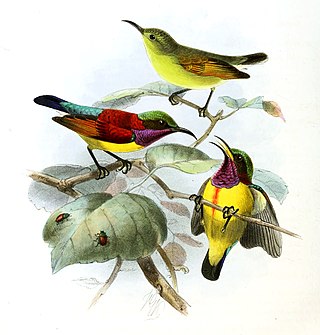
The purple-throated sunbird, is a species of bird in the family Nectariniidae. Its natural habitats are lowland tropical forests and subtropical or tropical mangrove forests of Maratua and the Philippines.

The black-headed antbird is a species of passerine bird in the antbird family Thamnophilidae. It is found in Brazil, Colombia, French Guiana, Guyana, Peru, Suriname, and Venezuela. Its natural habitat is subtropical or tropical moist lowland forests.
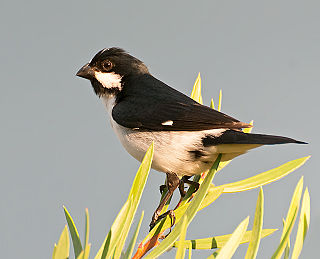
The lined seedeater is a species of bird in the family Thraupidae.

The ruddy-breasted seedeater is a species of bird in the tanager family Thraupidae. It is found in Brazil, Colombia, Costa Rica, Ecuador, El Salvador, French Guiana, Guatemala, Guyana, Honduras, Mexico, Nicaragua, Panama, Suriname, Trinidad and Tobago, and Venezuela. Its natural habitats are dry savanna, subtropical or tropical seasonally wet or flooded lowland grassland, and heavily degraded former forest.
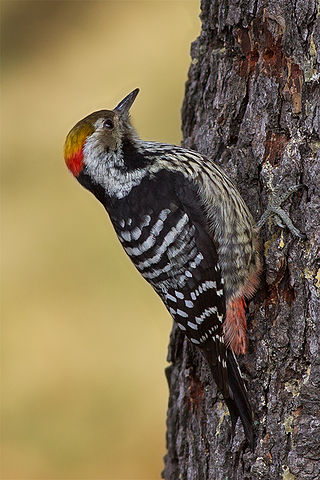
The brown-fronted woodpecker is a species of bird in the family Picidae. It ranges across the northern regions of the Indian subcontinent, primarily the lower-to-middle altitudes of the Himalayas. It is found in Afghanistan, India, Nepal, Pakistan and Bhutan.

Dendrocoptes is a genus of woodpeckers in the native to Eurasia.


